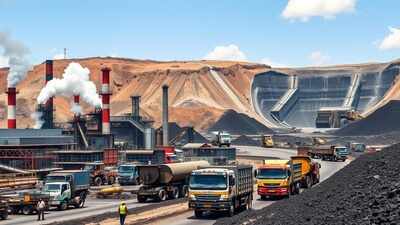India’s dependence on coking coal is expected to grow considerably over the next five years, as the nation pushes towards its ambitious goal of 300 million tonnes (MT) of steel production capacity by 2030, according to a new report by EY Parthenon in partnership with the Indian Steel Association (ISA).As per news agency ANI, the report highlights that India, the world’s second-largest steel producer, consumes 95 per cent of its coking coal within the steel sector, mainly through the blast furnace-basic oxygen furnace (BF-BOF) route. his process currently makes up about 65 per cent of installed capacity and 58 per cent of actual output. Demand for coking coal is therefore projected to surge from 87 MT in FY25 to around 135 MT by FY30.To address this rising need, the government is advancing its Atmanirbhar Coal Mission under Mission Coking Coal. The plan aims to increase raw domestic output to 140 MT by 2030, with 105 MT expected from Coal India and 35 MT from private allocations. Washed coal capacity is also targeted to grow to 15 MT. Policy measures, including 100 per cent FDI in mining, revenue-sharing auctions, and capital subsidies of up to 30 per cent for washeries, are expected to cut import reliance from nearly 90 per cent today to below 80 per cent by the end of the decade.Vinayak Vipul, Partner at EY Parthenon, underlined the importance of beneficiation and diversification. “The way ahead is clear—India must accelerate beneficiation to unlock the true value of its reserves, diversify sourcing to reduce risk, and invest in technologies that pave the way toward low-carbon steel. Building a transparent pricing index and a national reserve will be equally critical,” he said, as per ANI.With coal-based steelmaking responsible for 12 per cent of India’s greenhouse gas emissions and up to 8 per cent globally, the report stresses the urgency of decarbonisation. Cleaner technologies such as green hydrogen-based DRI, scrap-fed electric arc furnaces, and carbon capture are seen as vital to achieving the steel industry’s net-zero goal by 2070.Naveen Jindal, President of ISA, called securing reliable coal supplies a matter of strategic importance. “India’s steel industry is entering a transformative era, driven by rising domestic demand and global competition. Coking coal remains the backbone of steelmaking, and securing a reliable, high-quality supply is a strategic necessity for national growth,” he said.The push for self-sufficiency comes even as domestic coal production has faced fluctuations. According to news agency PTI, India’s coal output fell slightly by 0.6 per cent to 381.75 MT in April–August this year, though August production rose more than 11 per cent year-on-year. Coal India, which accounts for over 80 per cent of supply, produced 280.15 MT in the five-month period.The report concludes that building joint industry-government ventures, expanding washery infrastructure, setting up strategic stockpiles at ports, and forging overseas mine partnerships will be essential to securing India’s supply chains while balancing growth with sustainability.









